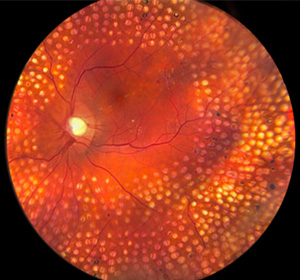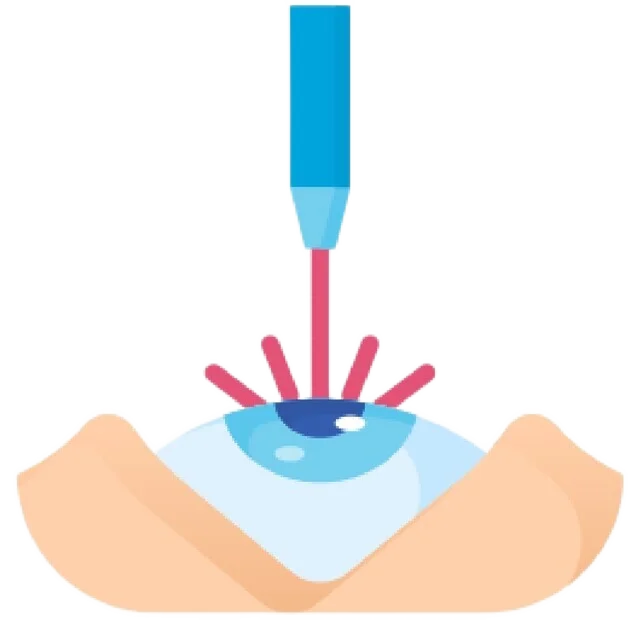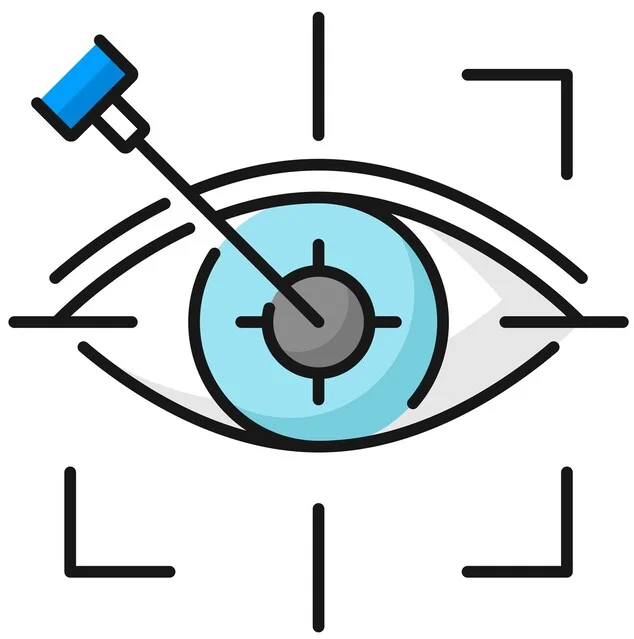
What is Surgery for High Myopia?
Surgery for high myopia refers to surgeries employed in the treatment of high myopia. Some of these surgeries include photorefractive keratectomy (PRK), LASIK (laser in-situ keratomileusis), Refractive Lens Exchange (RLE), and phakic intraocular lenses (pIOLs).
Myopia, also referred to as nearsightedness, is an eye condition defined by a refractive defect or error in visual focusing. When you are nearsighted, nearby objects can be seen clearly, but objects in the distance appear blurry. High myopia occurs when a patient’s myopia requires -5 diopters or more of correction. A diopter is a unit that measures the focusing power of a prescription lens. A negative diopter reading indicates nearsightedness, and the higher the negative number, the thicker your lenses will be. High myopia increases the risk of blinding eye conditions, such as macular degeneration, retinal detachment, glaucoma, and cataract.
Preparation for High Myopia Surgery
Prior to your high myopia surgery, your doctor will review your medical history and perform a thorough eye examination to:
- Test your vision
- Measure your pupil size
- Measure and map the surface of the cornea
- Measure the refractive error in each eye
- Check for other eye problems
Your doctor may also ask you to follow other preoperative instructions, such as:
- Eat a light meal before coming for the procedure
- Prescribe antibiotic drops and anti-inflammatory drops for a few days before surgery to prevent infection and inflammation
- Take all your usual prescribed medications
- Do not apply any eye makeup
- Do not wear any bulky hair accessories
- Wear comfortable clothing
Postoperative Care and Recovery
Following the surgery, you can expect some irritation as your eyes will be dry. You will be given medicines and eye drops to keep your eyes moist and to prevent pain and infection. Your doctor may advise you to use a patch over your eyes at night until they heal. You may have problems with the vision for the first day after the procedure, but healing occurs fairly rapidly, and you may experience improved vision in a few days. You will need to follow up with your eye doctor in one or two days and keep regular follow-up appointments periodically during the first six months. Most people can return to work in a week. Other instructions may include:
- Arrange for someone to drive you home.
- Keep both eyes closed and rest as much as possible during recovery.
- Limit reading and watching TV for the first few days.
- Do not swim or use a hot tub, spa, or whirlpool for at least 2 weeks to reduce the risk of infection.
- Avoid strenuous activities and contact sports for a few weeks.
- Wear sunglasses while outdoors to prevent discomfort from sun exposure.
Risks and Complications
Surgery for high myopia is a relatively safe procedure; however, as with any surgery, some risks and complications may occur, such as the following:
- Infection, inflammation, pain, or redness
- Increased intraocular pressure
- Undercorrection
- Overcorrection
- Dry eyes
- Delayed surface healing
- Vision abnormalities, such as experiencing glares, halo, or double vision temporarily
- Astigmatism (an imperfection in the curvature of your eye’s cornea or lens)
FAQ's - Regarding Surgery for High Myopia
Which Surgery Is Best for High Myopia?
For high myopia, several surgical options can help correct vision. The choice depends on various factors such as the degree of myopia, corneal thickness, and overall eye health. Here are some common surgical options:
- LASIK (Laser-Assisted in Situ Keratomileusis): Laser eye surgery for high myopia. LASIK is a widely used refractive eye surgery to correct nearsightedness, farsightedness, presbyopia (loss of ability to focus on nearby objects), and astigmatism (improper curvature of the eye’s surface). This procedure involves reshaping the cornea using a laser to correct vision, allowing proper focusing of the light that passes through the cornea onto the retina (light-sensitive membrane at the back of the eye). It’s suitable for people with moderate to high myopia but may not be recommended for those with very thin corneas or certain corneal irregularities.
Procedure: You will be seated in a reclining chair and given medication to relax you. Eye drops will be instilled to numb your eyes. Your doctor will use a special instrument to keep your eyes open during the procedure. You will be asked to focus on a source of light in order to keep your eye fixed during the procedure. Your doctor will then use a special cutting laser to cut a thin flap in the cornea similar to a hinge. The flap will then be peeled back and the underlying corneal tissue will be remoulded. Once the cornea is reshaped appropriately so that it properly focuses light onto the retina, your surgery will be completed by folding the cornea flap back into place, where it will heal normally without the need for stitches. The entire procedure takes around 30 minutes or less.
2. PRK (Photorefractive Keratectomy): Similar to LASIK, PRK is also a type of laser eye surgery for high myopia and also reshapes the cornea using a laser so that light entering the eye is correctly focused on the retina to deliver clear vision without the need for contact lenses or glasses.. However, instead of creating a flap in the cornea, the outer layer is removed entirely. PRK may be a better option for individuals with thinner corneas or those involved in contact sports where the risk of corneal flap dislocation is a concern.
Procedure: PRK is a painless procedure that is performed under local anaesthesia in an outpatient setting and usually takes about 15 minutes. It involves the following steps:
- Your surgeon will first numb your eye with anaesthetic eye drops.
- An eyelid holder will be placed on your eye to prevent the eye from blinking.
- You will be asked to focus on a target light so that the eye remains still.
- The outer layer of epithelial cells from the cornea is removed using a blade, special brush, alcohol solution, or laser.
- Computer-controlled pulses of light energy or laser are used to reshape the cornea.
- A contact lens is placed on the eye as a bandage for 4 to 6 days while the epithelium of the cornea heals.
- A medical professional will remove the “bandage” contact lens once the epithelium heals in 4 to 6 days.
3. Implantable Collamer Lenses (ICL): This involves implanting a thin lens between the iris and the natural lens of the eye. ICLs are suitable for individuals with high myopia who may not be good candidates for corneal-based surgeries. This type of eye surgery for high myopia does not involve a laser.
4. Refractive Lens Exchange (RLE): Refractive lens exchange is used for the correction of severe farsightedness, nearsightedness, presbyopia (diminished ability to focus on near objects), and astigmatism (blurred vision) that is not easily managed by other refractive procedures. In refractive errors such as hyperopia (farsightedness) or myopia (nearsightedness), the light entering the eye does not focus properly on the retina because of the lens which is either too weak or too strong to help focus light properly. The refractive lens exchange procedure corrects the error and focuses the light on the retina by removing the natural lens in the eye and replacing it with a new artificial lens, thus reducing or eliminating the need for additional glasses or contact lenses. This area of surgery for high myopia is rapidly expanding due to advances in lens technology. Mr Majid is the first surgeon in the UK to implant the new Alcon Clareon Toric lens and will shortly also be implanting the new Alcon Clareon Panoptix Lens by invitation. This lens will be available to his patients before a general release in the UK. It is already available in the USA.. Please get in touch if you wish to consider the exciting new Alcon Clareon Panoptix Multifocal lens.
Procedure: The RLE procedure usually takes about 20 minutes and is performed under local anaesthesia. Once the eye is numbed, a tiny incision is made in the periphery of the cornea. Your surgeon uses an ultrasound probe to break up the lens which is then removed by suction. This process is called phacoemulsification. Then the plastic lens is introduced in the same lens capsule as the natural lens. The incision heals on its own and does not require any sutures. Your doctor may administer antibiotic eye drops and place a patch over the eye to protect and facilitate healing.
5. Phakic Intraocular Lens (PIOL): Similar to ICL, PIOL involves implanting a lens made of silicone or plastic into the eye without removing the natural lens to minimise your need for glasses or contact lenses. Phakic lenses work by correcting the refractive error- that is the error in the eye’s focusing power. Phakic lenses cause the light that enters the eye to be focused properly on the retina and thus, provide clear distance vision. This option is often considered for individuals with high myopia who are not good candidates for corneal-based surgeries.
Procedure: For a phakic intraocular lens implant surgery, you are placed in the supine position, on your back with your face towards the ceiling.
- Your eye is cleaned.
- A lid speculum is used to hold your eyelids open.
- You are administered local anaesthesia in the form of eye drops to numb the eye or it could be given as an injection around the eye.
- You may also be administered another medication such as a sedative through the intravenous route to keep you relaxed.
- A tiny incision is made in the front of your eye. It could be in the cornea (the transparent part of your eye), sclera (the white part of your eye), or limbus (where the cornea meets the sclera).
- A lubricant may be applied near or inside the incision to facilitate smooth insertion of the lens and protect the back of the cornea during lens insertion.
- The phakic intraocular lens is inserted through the incision and placed either in front or just behind the iris.
- The incision may be closed with tiny stitches.
- Your doctor may administer medicated eye drops or apply ointment to your eye.
- Your eye is covered with a patch for protection while it heals.
The best eye surgery for high myopia depends on factors such as the individual’s eye anatomy, age, occupation, and lifestyle preferences. It’s essential to consult with an experienced ophthalmologist, such as Mr Majid, to determine the most suitable option for your specific case.
What Is the Cost for the Surgery for High Myopia in the UK?
The cost of laser eye surgery for high myopia in the UK can vary depending on several factors, including the type of procedure chosen, the surgeon’s fees, and any additional preoperative or postoperative care required.
On average, laser refractive surgeries such as LASIK or PRK for high myopia can range from £1000 to £3000 per eye. This cost may include the surgical procedure itself, preoperative assessments, postoperative medications, and follow-up visits.
Lens based procedures such as Refractive Lens Exchange (RLE) or Implantable collamer lenses (ICLs) may be more expensive than laser refractive surgeries, with costs typically ranging from £3000 to £5000 per eye. This higher cost reflects the additional expenses associated with the lens implantation procedure and the specialised intraocular lenses used.
It’s essential to discuss the cost of surgery for high myopia with the treating surgeon or clinic and inquire about any available financing options or payment plans. Additionally, patients should consider the long-term value of improved vision and quality of life when evaluating the cost of surgical intervention.
What Is the Success Rate of Surgery for High Myopia?
The success rate of laser eye surgery for high myopia varies depending on the type of procedure performed, the severity of the refractive error, and individual patient factors. Generally, laser refractive surgeries such as LASIK and PRK have high success rates for correcting myopia, with the majority of patients achieving significant improvements in vision.
Studies have shown that LASIK and PRK procedures for high myopia can result in excellent visual outcomes, with many patients achieving 20/20 vision or better following surgery. However, the success of these procedures may diminish with higher degrees of myopia or other complicating factors such as corneal irregularities or dry eye syndrome.
Refractive Lens Exchange (RLE) and Implantable collamer lenses (ICLs) also offer high success rates for correcting high myopia, particularly in patients with extremely high refractive errors. These lenses provide predictable and stable vision correction, with many patients experiencing improved visual acuity and reduced dependence on glasses or contact lenses.
Overall, the success rate of surgery for high myopia is excellent, with the vast majority of patients achieving significant improvements in vision and quality of life. However, individual outcomes may vary, and it’s essential for patients to discuss their expectations and concerns with their eye surgeon before undergoing any surgical intervention.
How Long is the Surgery for High Myopia?
The duration of eye surgery for high myopia can vary depending on the specific procedure performed and any additional preoperative or postoperative steps required. Generally, laser refractive surgeries such as LASIK or PRK for high myopia are relatively quick procedures, typically lasting between 10 to 30 minutes per eye.
During LASIK surgery, the creation of the corneal flap and subsequent laser ablation of corneal tissue are performed rapidly, with the entire procedure usually completed within minutes. PRK surgery may take slightly longer due to the removal of the epithelial layer of the cornea before laser ablation.
Refractive Lens Exchange (RLE) and Implantable collamer lens (ICL) surgery for high myopia may require more time compared to laser refractive surgeries, as the procedure involves implanting a specialised lens inside the eye. However, the surgical process is still relatively quick, typically taking between 20 to 30 minutes per eye.
Despite the short duration of surgery, patients should plan to spend several hours at the surgical facility on the day of the procedure to allow for preoperative preparations, postoperative monitoring, and recovery. Additionally, patients should arrange for transportation to and from the surgical center, as vision may be temporarily blurry or compromised immediately following surgery.
In summary, eye surgery for high myopia, whether through laser refractive procedures or implantable collamer lenses, is typically a quick and efficient process, offering patients the opportunity for significant and lasting vision correction with minimal disruption to their daily lives.







